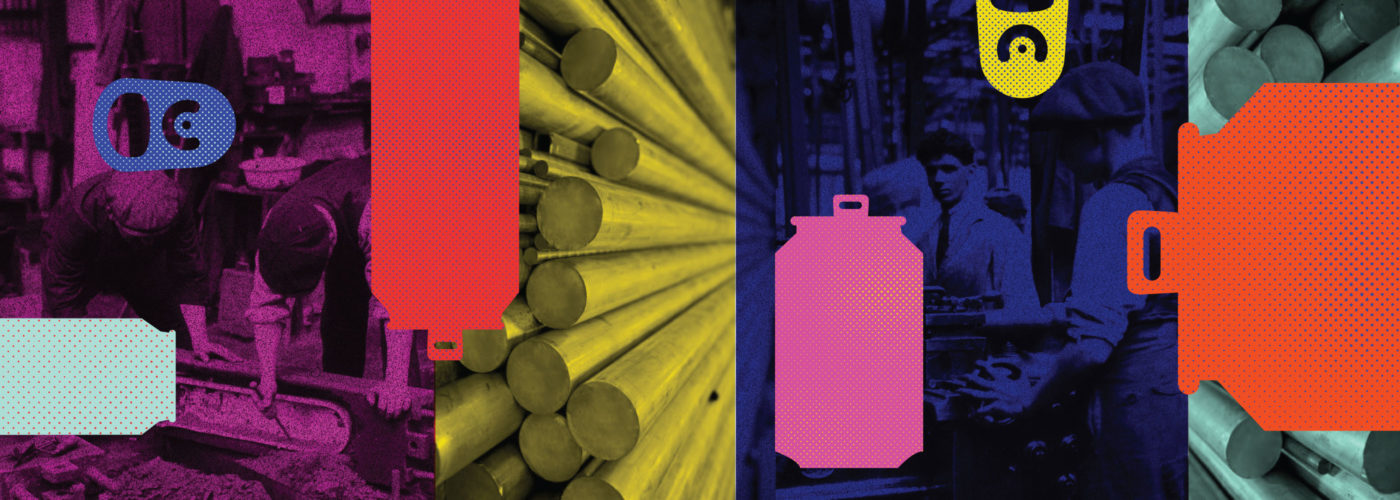Resources
Exploring Canning Trends (& the Can Shortage) with CanSource
A Macroview of the Canning Industry
What do craft beer, RTD cocktails, hard seltzer, THC/CBD beverages and kombucha have in common? They all over-index in cans. And when COVID caused the entire food and beverage industry to shelter in place in early 2020, this spurred thousands of breweries who had never before packaged their beer, to start buying every can they could find in order to get their beer out the door (and keep those doors open). This created a real deal aluminum shortage.
While this shortage was forecasted to happen throughout last summer, we (CODO) didn’t start feeling its effects until Q4 2020. That’s when brewery clients started to shift from ordering truckloads of printed cans to shrink sleeves. Or we would have to reformat a label to fit on three different templates because that’s how many vendors it would take to complete an order. It was chaos.
To discuss this topic as well as provide a deeper behind the scenes look at the canning industry, we’ve brought in Paige Sopcic, CEO of CanSource. What formats are on the rise, which verticals are growing and what does she see, from a macro level, as leading emergent trends as we head into 2021.


Hi Paige, thanks for your time! Please introduce yourself and CanSource.
 Paige
Paige
Hi Isaac and all the CODO fans out there! I’m the CEO of CanSource and live in Boulder, Colorado. CanSource has been serving the craft beverage industry for the last decade with shrink sleeved cans in low minimum orders.
We have 4 plants across the U.S. and our team works tirelessly is to ensure what is on the outside of the can matches the quality and craftmanship of what goes inside the can.

You’re in a place, similar to CODO, where you work with hundreds (thousands?) of breweries each year. This puts you in a position to see a constant flow of packaging at the macro level. I know peeking into your system would probably be akin to drinking from a firehose, BUT, have you been able to suss out any major package design trends coming through Can Source this year?
 Paige
Paige
A few design trends that stand out:
- Cans, cans, cans!
- A push into pastel colors, especially on matte-textured cans. Think Recess sparkling water or Aura Bora herbal sparkling water.
- Ingredient dominance! This reminds me of the trend we saw in food a few years ago with brands like RxBars spotlighting the ingredient list over everything else. A good example here is CarryOn, the CBD water brand from Ocean Spray.

What other verticals have you seen movement in this year? Kombucha? Hard seltzer? Cold brew coffee? CBD/THC? RTD cocktails?
 Paige
Paige
In can-volume, our top 5 growth areas in 2020 are:
- Kombucha (including hard kombucha)
- Non-alcoholic (i.e water, soda, better-for-you drinks)
- RTD cocktails
- CBD/THC
- Wine
We are seeing a lot of creativity outside the alcohol segment this year, especially in better-for-you categories like Koios’s Fit Soda, Moment’s Drink Your Meditation or Cloud Water + Immunity sparking water. That said, beer continues to be our number one vertical!

The aluminum shortage appears to be real. We’ve had several clients have to shift initiatives and packaging formats to accommodate a disrupted supply chain. What are you seeing on your end? And when can breweries expect to be able to place an order and receive it quickly like the old days?
 Paige
Paige
The shortage is unfortunately very real. Before COVID, there was an upswell in can-demand due to the convenience, portability, and recyclability of cans. With COVID, the demand was driven to an all-time high.
Can manufacturers are investing in new capacity in 2021 and we are adding more lines to meet this demand. Our goal is to return to normal lead-times by Spring 2021. We know our customers need quick turnaround times and dependable delivery and they will hold us to this timeline.

Build a stronger brand.
Sell more beer.
Join 7,500+ other beer industry folks and sign up for our monthly Beer Branding Trends Newsletter.

Beer Branding Trends 2.0

Have you been getting hounded for brite cans alone, without a shrink wrap due to the shortage?
 Paige
Paige
YES! Pre-COVID, I would have told you we sell sleeved cans not brites. During COVID, it has been important to us to provide brite cans to customers that had delays or long lead times from us on their sleeved can orders. We do everything we can to bridge the gap and prevent customers from wasting product or having empty shelves.

I know the vast majority of breweries will want 12/16oz cans. But are you seeing an uptick in other formats? Sleeks, in particular, but also, stovepipes, 8oz cans, and crowlers?
 Paige
Paige
At the beginning of COVID we saw a meaningful spike in crowlers, but that has settled down lately. More noticeable is the demand for sleeks that continues to grow! Seltzer, kombucha, RTDs and sparkling water are all fantastic fits for 12oz sleek cans because they signal to a different buyer. We sell 8oz, 7.5oz, 19.2oz, 187mL, 250mL and will adapt to whatever other sizes we see gaining popularity.

What percentage of your clients opt for a matte finish? Whenever I see a wrapped can that isn’t matte, I just feel like it’s not as nice as it could be.
 Paige
Paige
Around 35% of our customers choose matte cans. Matte cans feel luxurious, which I love too. They also stand out on the shelf next to gloss cans.

We’ve seen some shrink wrapped bottles in the beer and cannabis space. Is this something CanSource might eventually get into?
 Paige
Paige
The market for shrink wrapped applications is massive! The more I pay attention, the more I see shrink wrapped products. That said, our business is cans. We like having a hyper focus on cans—it makes us good at what we do.

For the last few years, we’ve seen a shift away from shrink sleeves and towards breweries buying bright cans in bulk. This allows them to kick out a pressure sensitive label at whatever quantity they need. Has this affected your business or are you guys booming as much as ever?
 Paige
Paige
Of course. We lose some customers or a percent of a customer’s total volume to PSLs (Pressure Sensitive Labels). PSLs can be a great fit for a customer that is doing many, small, SKUs.
That said, the growth we are seeing in shrink is fantastic. Shrink sleeves are high-quality and offer full-can coverage, as well as unique finishes like matte. Our goal is for cans to stand out on the shelf and command a premium price. On top of that, we eliminate the headache and expense of buying cans in bulk. We have a partnership with Ball that helps us be a more dependable option. Buying cans in bulk can be a good option as long as businesses avoid having too much of their most important asset, cash, tied up in inventory.

Sustainable packaging is becoming increasingly more important to consumers, particularly with Gen Z (and I imagine this trend will accelerate amongst the Gen Alpha cohort as well). Can shrink sleeves be produced sustainably?
 Paige
Paige
Sustainably focused brands are quickly moving to cans (and away from bottles or plastic) as aluminum is infinitely recyclable! From the conversations we’ve had with Recyclers, shrink sleeved cans can be recycled and the sleeve is burned off in the recycling process. Right now, we are working on using a thinner sleeve to reduce the amount of plastic per sleeve.
Another option is for producers to buy perforated sleeves from us, which allow consumers to easily remove the sleeve. This is common in food packaging with shrink labels.

A selfish question here (maybe more for my curiosity than the reader)—do you see any major differences between branding a consumer-facing (B2C) business (say, a brewery) and a business-to-business (B2B) company like CanSource?
 Paige
Paige
Building a brand is critical for B2B companies like it is for B2C companies. We want the CanSource brand to signal quality, service and dependability and be the first partner producers think of when they need sleeved cans just-in-time! That said, we do not have the same high bar as B2C companies when it comes to our social media presence. We also don’t have the same pressure to have our brand stand out on the shelf next to tens or hundreds of our competitors.

We believe good design is good business. What have you seen, or directly influenced at CanSource, that backs up this claim?
 Paige
Paige
I could not agree more. At CanSource, we work with hundreds of craft beverage producers every year…some have product market fit and others are still searching for it. What I have seen is that craft beverage producers cannot only have a delicious product. They need a delicious product AND good design. The brands that have both are sustainable businesses and will continue to see product fly off the shelf!

Build a stronger brand.
Sell more beer.
Join 7,500+ other beer industry folks and sign up for our monthly Beer Branding Trends Newsletter.


